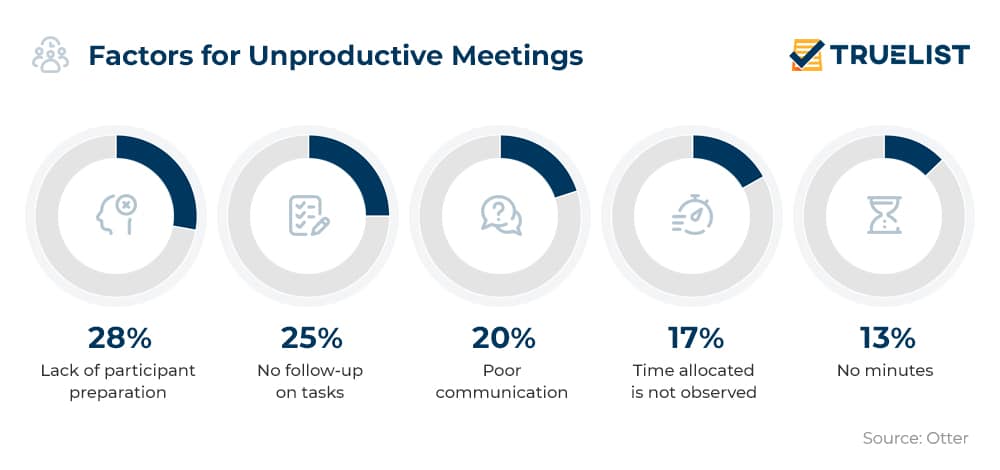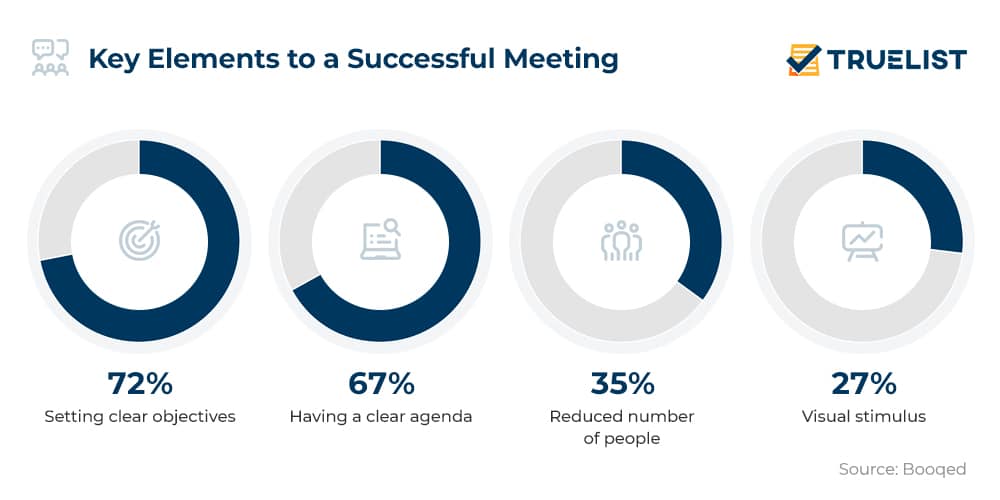When is the best time to have a meeting? When can you be sure your employees won’t doze off the minute the meeting starts and how long should it go on? Today’s workers attend more meetings than ever and it’s taking a toll on both effectiveness and productivity. Meeting statistics show a trend of hundreds of thousands of hours lost in meetings that went necessarily needed. Let’s examine what is it that happens in meetings and what is the biggest hurdle to productivity; how they can become less of a nuisance and serve their purpose in the best possible way, without everyone daydreaming through the hour.
Meeting Statistics (Editor’s Choice)
- The best time for meetings is on a Tuesday at 2:30 p.m. (Hourly)
- The appointment scheduling software market will grow to $546.31 million by 2026. (Allied Market Research)
- People would rather visit the dentist than sit through a bad meeting. (Better Meetings)
- 40% of people spend some 30 minutes searching for a good meeting room. (Booqed)
- 83% of large companies plan to buy video call tools. (Medium)
- Monday is the worst day for meetings for 47% of people. (Better Meetings)
- Video conferencing potentially reduces travel costs by 30%. (UC Today)
Business Meeting Statistics
1. Management spends up to 50% of their work time on meetings.
Do you ever feel like you have meetings about meetings? If you work in management, chances are you are not far off. Stats show that middle managers are stuck in a meeting for about 35% of their average time spent at work. Upper management has it worse though, with meetings accounting for about half of their time at work.
(Muse)
2. People have at least eight meetings per week on average.
The higher the seniority, the more meetings an employee has. If you work above junior level, chances are you will have 10 meetings per week. That number goes to 12 for executive management and up, according to time spent in meetings statistics, to reach 17 meetings per week for VPs, directors, and C-level employees, pointing to much more time spent in meetings.
(Booqed)
3. The average delay per meeting is 10 minutes and 40 seconds.
This means we waste three days and two hours every year just waiting for meetings to start. Late meetings cause senior executives even more trouble since the average delay for those is 15 minutes and 42 seconds. Which amounts to five days and 19 hours lost every year. Facts about meetings show that looking for a place for meetings is among the major causes of these delays — up to 40% of employees say they spend around 30 minutes looking for a good space for team meetings.
(Swiped On, Booqed)
5. Lack of participant preparation is the main culprit of ineffective meetings.
With the cost of ineffective meetings reaching a massive $399 billion a year in the US alone, it’s important to see what makes meetings unproductive. Lack of participant preparation leads the pack with 28%, followed by poor communication with 20%, according to statistics on ineffective meetings.
(Otter)

6. 55% of employees are most irritated by colleagues taking phone calls during meetings.
Then, 50% of employees are annoyed by colleagues who interrupt, while 49% don’t like it when people don’t listen to the contribution of others, the same as those who are annoyed at those being late or leaving early. 46% meanwhile hate it when others talk about nothing for a long time.
(Better Meetings)
7. 96% of employees have missed meetings.
Late for meeting statistics show that most need to improve their meeting attendance rate. What’s more, up to 91% have daydreamed, 39% have slept, and 73% have worked on other things in a meeting.
(Booqed)
8. Some people would rather go to the dentist than attend a bad meeting.
That stat should tell you a lot about how much people hate unproductive meetings. Other traditionally undesirable activities that people would rather do than sit at a bad meeting include watching C–SPAN in a waiting room, calling Comcast, and talking politics at a family dinner.
(Better Meetings)
9. 35% of employees say fewer people in the room is the formula for a successful meeting.
Time spent in meetings research points out several solutions to ineffectiveness according to attendees, meeting room statistics show. Around 72% of professionals say that having clear objectives is paramount to having a good meeting while 67% point out having a clear agenda is the most important.
(Booqed)

10. 71% of senior executives say meetings are unproductive andwhat a inefficient.
The 182 senior executive respondents involved in this survey said that after rethinking meeting strategies and approaches, there were noticeable improvements, such as:
- 42% increase in team collaboration
- 32% increase in the feeling of safety to speak up and express opinions
- 28% increase in overall team performance.
In addition to that, one of the other interesting facts about meetings is that employees’ reported their work/life balance satisfaction went up from 62% to 92% when meetings were improved.
(Harvard Business Report)
11. The best time for a meeting is Tuesday at 2:30 p.m.
Not only that it’s the most productive time slot attendance-wise, but it also proved to be an employee favorite. When asked what was the best day for a meeting 29% answered Tuesday and 25% chose Wednesday. Statistics on ineffective meetings reveal that the worst day for a meeting for 47% of people was Monday, followed by 40% of those who choose Friday.
(Better Meetings)
12. Around 70% of employees saw an increase in meetings due to Covid-19.
The shift from office to remote work brought on a wave of meetings and a 10% increase in average time spent in meetings per week which equals three more meetings each week. The increase was understandable in the light of new circumstances and was observed across all types of teams and industries. Time spent in meetings statistics show that short meetings under half an hour saw an increase of 22%. In contrast, the long ones, lasting over 60 minutes decreased by 11%. One-on-one sessions meanwhile rose by 18%.
(Better Meetings)
13. The appointment scheduling software market size will soar to $546.31 million by 2026.
The global appointment scheduling software market grew from $205.85 million in 2018 and will continue at a CAGR of 13.1% from 2019 to 2026. It is not surprising, given that these solutions make time spent at work more efficient, helping employees avoid scheduling conflicts or odd time gaps, meetings stacked back to back, etc.
(Allied Market Research)
Virtual Meeting Statistics
14. Up to 36.2 million US employees will work remotely by 2025.
This is an 87% increase from the years preceding the pandemic, data from Upwork shows. This is also likely to contribute to a rise in virtual meetings. On the upside, 55% of companies report that video calls increase employee engagement, and 66% of executives find that video calls help them have a better understanding and connection with the freelancers they hire. 87% of people further claim that video conferencing makes decision-making within the team faster.
(Get Voip)
15. Around 83% of large companies are likely to purchase video calling tools.
And the same goes for 27.6% of small businesses who plan on buying video conferencing software. Business meeting statistics show that the use of video calls reaches into every department for all types of meetings in the workplace, from hiring, onboarding, and training sessions to team meetings, reports, webinars, and events, even game nights.
(Medium)
16. 75% of CEOs believe video calls will replace audio conference calls completely.
Video calls have taken over audio even before the pandemic years. About around 78% of workers use video calls for team meetings, while up to 45% of teams use video conferencing every day or every week. More importantly, 67% of people are more open to communication and contribute during video calls than they do in person.
(Get Voip)
The Bottom Line
Make them shorter, less frequent, and keep them to the point — if there’s anything statistics on workplace meetings conclusively show, it’s that. Productivity losses are enormous both in time wasted sitting around doing nothing which is what most of the employees do in meetings and in money lost since they could be doing something profitable. So, as with a lot of things in life, when it comes to meetings, less is more.
FAQ
What percentage of meetings are unproductive?
Up to 71% of respondents in a survey found that most meetings are inefficient and unproductive.
(Harvard Business Review)
What percentage of time should be spent in meetings?
Productive staff meetings take up only 10% of the workweek according to statistics on workplace meetings.
(Better Meetings)
How many meetings are held each day?
There are 11 million meetings held each day. This translates to 55 million meetings per week and an astonishing 220 million meetings per year.
(Otter)
Are too many meetings unproductive?
Having meetings all day leads to falling behind on work. Too many meetings are unproductive and it is best not to go over three or four meetings in a day no matter the industry.
(Fellow)
Why too many meetings are a waste of time?
Meetings are a waste of time if there are too many of them because they cause fatigue that lowers the attention span and productivity. Virtual meeting statistics show that being exhausted from meetings also leads to an inability to focus and lowered performance, which in turn can cause demotivation of employees and even entire teams.
(Exceed Economist)
What day of the week is best for team meetings?
Research on meetings found that the best day of the week for team meetings is Tuesday. This is the day when most of the team members are free, present, and already immersed in the week’s tasks.
(Hourly)
How long should a meeting last?
A meeting should last around 30 minutes. Ideally, it should be between 15 and 30 minutes, according to meeting statistics, and it should not go over 60 minutes. If the subject matter is too broad and complex it should be divided into logical segments and more separate meetings. Too much time spent in meetings lowers the overall productivity throughout the day and cumulatively throughout the whole year.
(Fellow)
Why do meetings fail?
Meetings fail when they miss the primary task of conveying the purpose of the meeting to the attendants. Meeting room statistics show that a lot of time employees will leave a meeting wondering why they were there or why it was even called. Stats about the state of meetings further show that when the agenda is all over the place and people don’t get a chance to be heard and give feedback, they get bored and uninterested.
(The Ridgeway Centre)
Are meetings better in the morning or afternoon?
If you aim to make a decision and you want the team to be decisive and sharp the best time is to call a meeting at 10 am. If you need the most people there for things everyone needs to hear, then moving it to 2:30 p.m. is ideal. Late meetings rarely benefit anyone unless they are celebratory.
(Hourly)
How far in advance should you schedule a meeting?
Meetings are scheduled at least two days in advance, meeting statistics show, as this will give everyone time to arrange their workday and prepare the materials needed, or get better acquainted with the agenda and their tasks. This helps avoid confusion, repetitive explaining, and going back and forth as well as last-minute cancellations.
(INC)
Sources: Hourly, Allied Market Research, Better Meetings, Booqed, Medium, UC Today, Muse, Swiped On, Otter, Harvard Business Report, Get Voip, Fellow, Exceed Economist, Fellow, The Ridgeway Centre, INC

